Search engine optimization, known as SEO, is a mainstay of any digital strategy in 2020. SEO is no longer something that you should be planning as an afterthought but something you consider when creating all content. SEO in 2020 is something that you should be thinking about at the outset of any new development project, any website redesign or any new piece of content. You can ask yourself, “How are people going to find this content?” and “How are people searching for my Products or Services?”, and “What do they want to see?”
Where do you want to be with SEO? Start by analyzing your SEO health. This can be done by a variety of tools on the web, but one of the best tools out there to assess your current SEO health and keyword rankings is the Google Search Console. Let’s dive in on our Google Search Console tips and how you can find your top search terms.
Google Search Console is a free tool available to any website owner, manager, or webmaster that allows them to monitor major search metrics pertaining to their domains and subdomains. It ultimately allows you to view errors, manage sitemaps, request content to be removed from the web, and do a health check and see your active keyword performance in Google search.
You can utilize Google Search Console to start curating and solidifying your primary keyword lists. These lists will help you create key plans for your SEO strategy.
Gaining access to Google Search Console can be as easy as two or three button clicks as long as you have all of your account permissions handy. You may need your web developer or site-owner to help you verify the integration. To get started with Google Search Console you’ll need one of the following:
or
or
or
To begin access visit https://search.google.com/search-console and copy your website’s URL.
When you first load up Google Search Console you’ll be met with the following options:
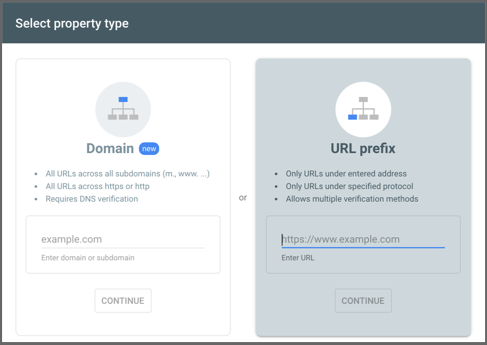
Domain-level registrations through Google Search Console allow you to get search statistics and management for every iteration of your website whether it’s a new subdomain, main domain or mobile-specific variations. This type of variation can only be verified through DNS or Website Domain Provider access.
URL Prefix Registrations are the most common type of Search Console registrations. These allow you to register specific subdomains, main domains or variations of your domains separately. There is a wide variety of methods that allow you to verify this type through including Google Analytics, Google Tag Manager and HTML file upload.
Available only on URL prefix verification and most times done automatically, verifying through Google Analytics occurs when the Google account you’re accessing Search Console with has administrative access to the Google Analytics account on your domain. This is our favorite method of verification because you should already have company-wide accounts setup that can be shared for access.
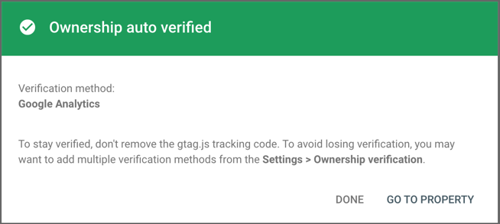
Tied closely with Google Analytics, the Google Tag Manager (GTM) verification method allows you to automatically verify your search console property if you have administrative access to the GTM container currently on your domain.
Once you finally get verified access to Google Search Console it may take up to 24 hours for data to start populating there, however, the sooner you can verify the sooner you can ensure you’ll be collecting data. The first menus you’ll be met with are quite simple: Overview, Performance, URL inspection, Coverage, Sitemaps and Removals as mentioned.
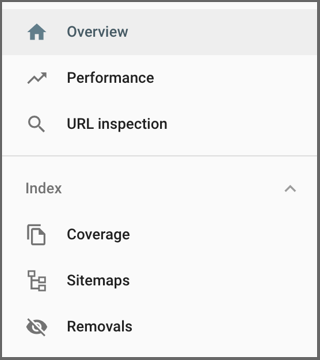
This tab allows you to fetch a URL and see exactly how the Googlebot sees that domain, rendered in as many details as the bots can acquire. This is the perfect way to validate your website’s look and feel, and make sure everything is being rendered properly.
The Coverage menu provides you with a comprehensive look at all the bot errors that Google has discovered while it has crawled your domain. You’ll find many details in this section ranging from specific instances of broken links to validation errors, described in detail. We make a habit out of checking ours once a month to ensure we’re staying on top of any errors that may pop up on our domain.
Your sitemap is the basic roadmap for how Google sees and crawls your website. Without one you’re leaving it up to Google to determine which pages it thinks are the most important to index. Within this menu, you can submit sitemaps, remove sitemaps, and check the validation for your existing sitemaps to ensure Google is following the flow of your website as intended.
The Removals page allows you to request specific pages on your domain to be removed from index. While this is a possible solution to getting pages removed, we always recommend working with your website manager to add noindex/nofollow to any pages that you want to be removed from search.
It does take some time for these changes to be reflected, but it can be a successful removal method if you do not want a specific site to be crawled or to appear in search.
The Performance menu is the perfect place to take a look at exactly how users are finding your website. This menu will show important metrics like the number of clicks and impressions you’ve received from Google Search, the average click-through rate of your results, and the average position of your results in search.
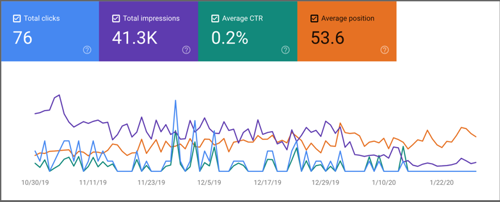
One important thing to note is that these results are only for Google results. If you’re looking to build a comprehensive profile of your website’s organic performance, you’ll need to leverage the organic tracking from Google Analytics or another search engine optimization tool such as Bing Webmaster Tools. (https://www.bing.com/webmaster/help/webmaster-support-24ab5ebf)
From within this performance menu, you’ll be able to find the high-level keywords that users are searching to find your website. For example:
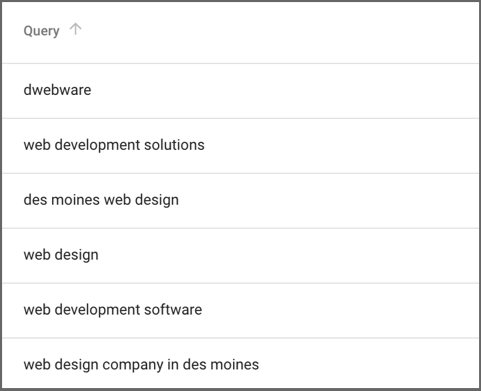
These terms are for Google search only, but as Google is roughly 80% of all search traffic, this will give you a great indication as to how your users are accessing your domain.
Sorting by Clicks, you’ll be able to see all the top terms that are driving the most traffic to your website. These terms are some of the most important terms for your domain as it sits right now, so it’s important to take these terms into account when revising your existing content.
You may find some unexpected terms as you monitor these terms. And now is the perfect time to begin validating these terms. Are there terms for which you want to be appearing? Are there any major terms missing?
Sorting by impressions, you’ll see terms that have a lot of impressions within search, but very few clicks. These terms are perfect places to start when optimizing as well as additional terms to optimize your pages for. Checking Google Search Console routinely will help you understand not only your domain’s overall health but also any changes in the way people are finding your website and business.
If you are curious about what a full SEO strategy looks like for your business in 2020, DWebware, a web development company in Des Moines, can help! Our team of SEO experts and dedicated content writers can help you climb the results page and rank better for your high-priority terms. Contact us today for more information!
Go Back